Peach trees can bring you fruit that is sweet and healthy. If you have a peach tree planted in your yard, picking the fruit can serve as a great stress reliever. But if you're wondering how long the tree will live, you're in luck! We've done some research and found the answer.
A peach tree has an average lifespan of around 15 to 20 years. The tree produces the most fruit during years four to eight and will produce less fruit as time goes by.
Peach trees can live longer than their average lifespan if you take care of them properly. Read on to learn more, as we will cover all you need to know about peach trees!
Average Lifespan Of A Peach Tree
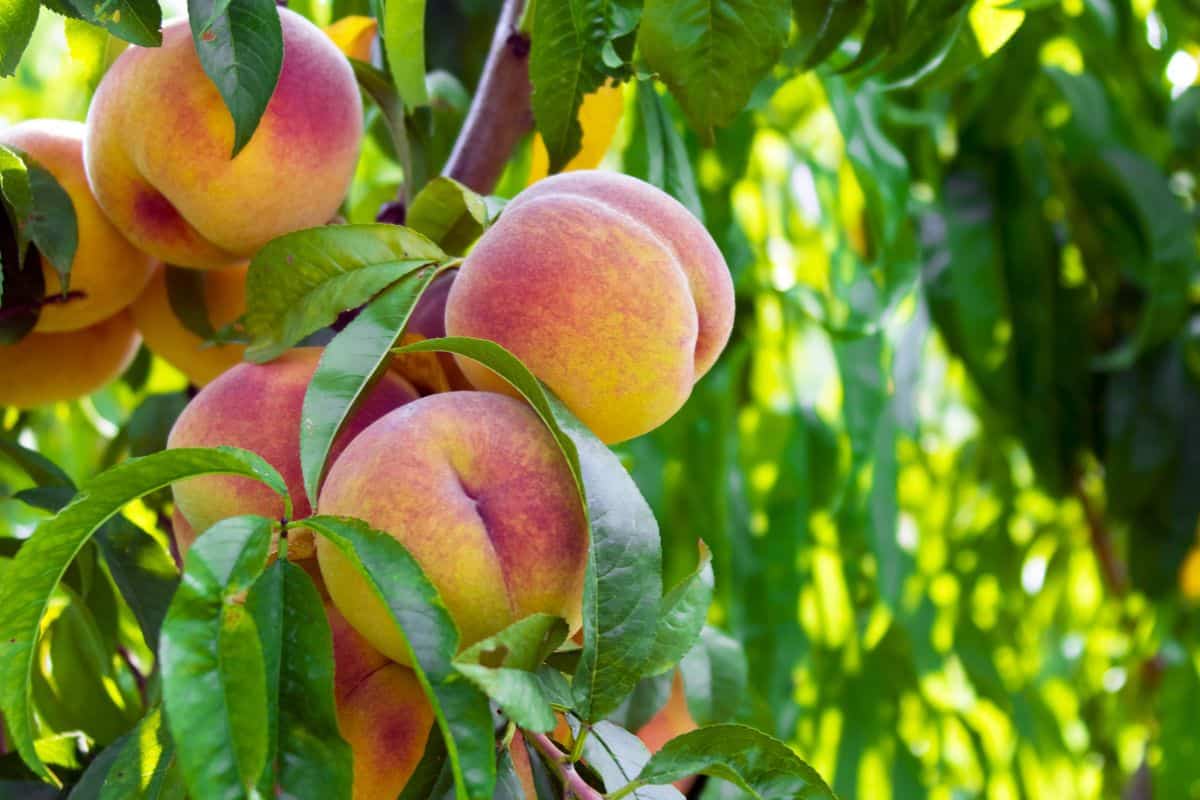
Peach trees are grown across the United States, especially in parts of California. The tree grows quickly and can reach a maximum height of 25 feet. It can be as wide as 25 feet if left unpruned.
The tree can also bear fruit during its third year. However, the tree has a short average lifespan of 15 to 20 years, unlike other fruit trees that can last 20 to 30 years or more.
The longevity of your peach trees will depend on how you treat them. Properly taking care of your trees will help them live longer and produce more fruit. If you want your peach trees to stay healthy, make sure that you regularly prune, fertilize, and spray them.
Also, remember to provide adequate summer watering and maintain deep and well-drained soil to prevent peach leaf curl and brown rot.
Having a healthy tree can also prevent disease and pest attacks. Pests can eat and damage different parts of your tree, such as its leaves, fruit, branches, trunks, and roots. If you can prevent this from happening, your trees may live longer.
When you see signs of pests attacking your peach trees, getting rid of them should be your first priority. You can control pest attacks by using pesticides and fungicides.
Check out this oil concentrate pesticide on Amazon.
The compatibility of peach trees with your garden can also affect how long the trees will live. Peach trees grow the best in locations that have well-drained, fertile soil.
The location should also receive at least six to eight hours of full sunlight each day during the growing season. The sunlight is vital for abundant fruit production and for keeping fungal issues at bay.
How Can You Tell The Age Of A Peach Tree?
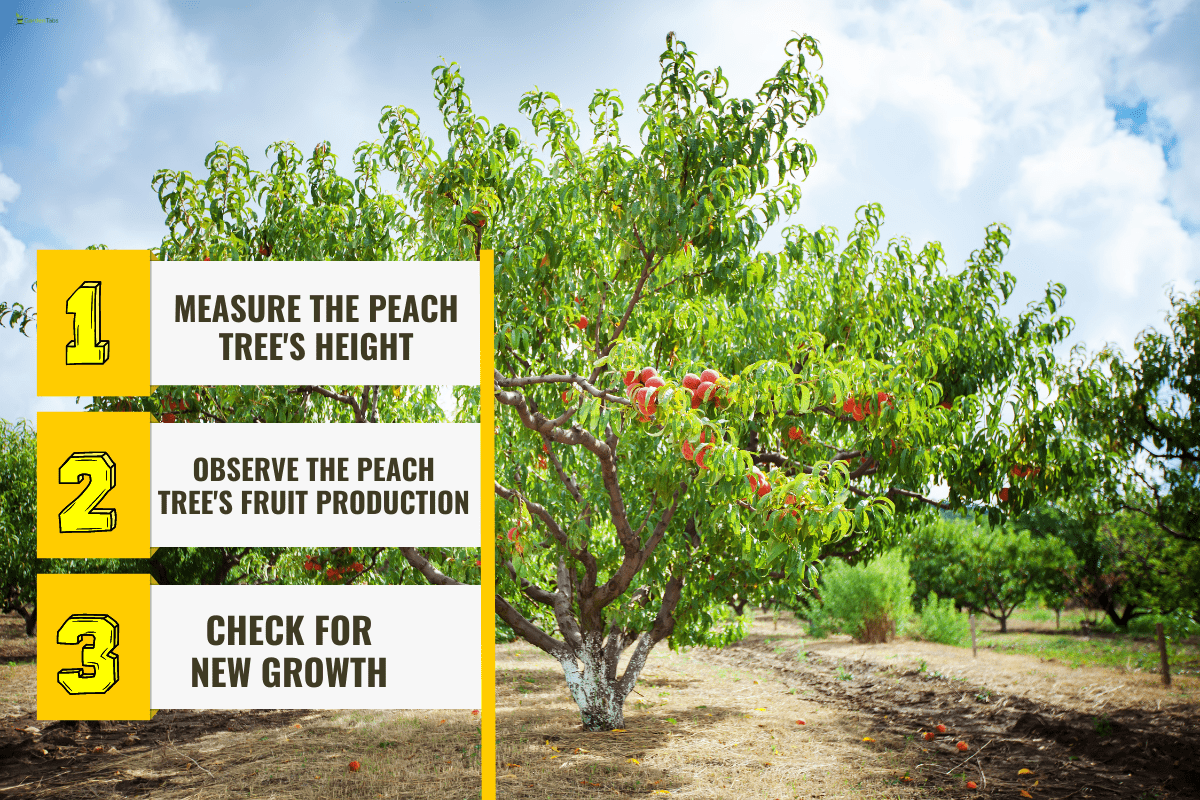
Growing a fruit tree can take years. You may lose track of your peach tree's age as time goes by. Don't worry because there are methods that you can use to tell the age of a peach tree:
1. Measure The Peach Tree's Height
A standard peach tree can grow to be about 25 feet tall, while a dwarf tree can grow up to six feet. You can estimate an unpruned peach tree's age by measuring its height, with one year per one foot. Even if your peach tree is pruned, the branch spread may be able to give you clues about its age.
2. Observe The Peach Tree's Fruit Production
A peach tree's fruit production can help you estimate its age. Peach trees can bear their first fruits within their third year. They can reach their peak production within six to eight years. Peach trees produce fruit for about 12 years.
With this in mind, observing the number of fruits your peach tree bears can give you an idea of how old it is. If your tree is full of fruit in the summer, it's probably between six and 18 years old, which means it's in its prime.
Meanwhile, if the tree is slender and only producing a little fruit, it's probably a young tree between three and five years old.
3. Check For New Growth
Peach trees produce less fruiting wood as they grow old. Checking for signs of new growth can help you tell the tree's age. If there's minimal new growth, the peach tree is probably old.
The tree's fruiting pattern can also indicate how old it is. If your tree is bearing flowers and fruit at the end of its long branches, it may be reaching the end of its lifespan.
When Is The Right Time To Prune Your Peach Tree?
Pruning your peach tree is important to keep it healthy. If not pruned properly, the tree's branches can become tangled, block sunlight, and prevent airflow.
Most fruit trees need to be pruned during winter when they are dormant. If you prune peach trees during winter, it makes them less cold-hardy and susceptible to dieback.
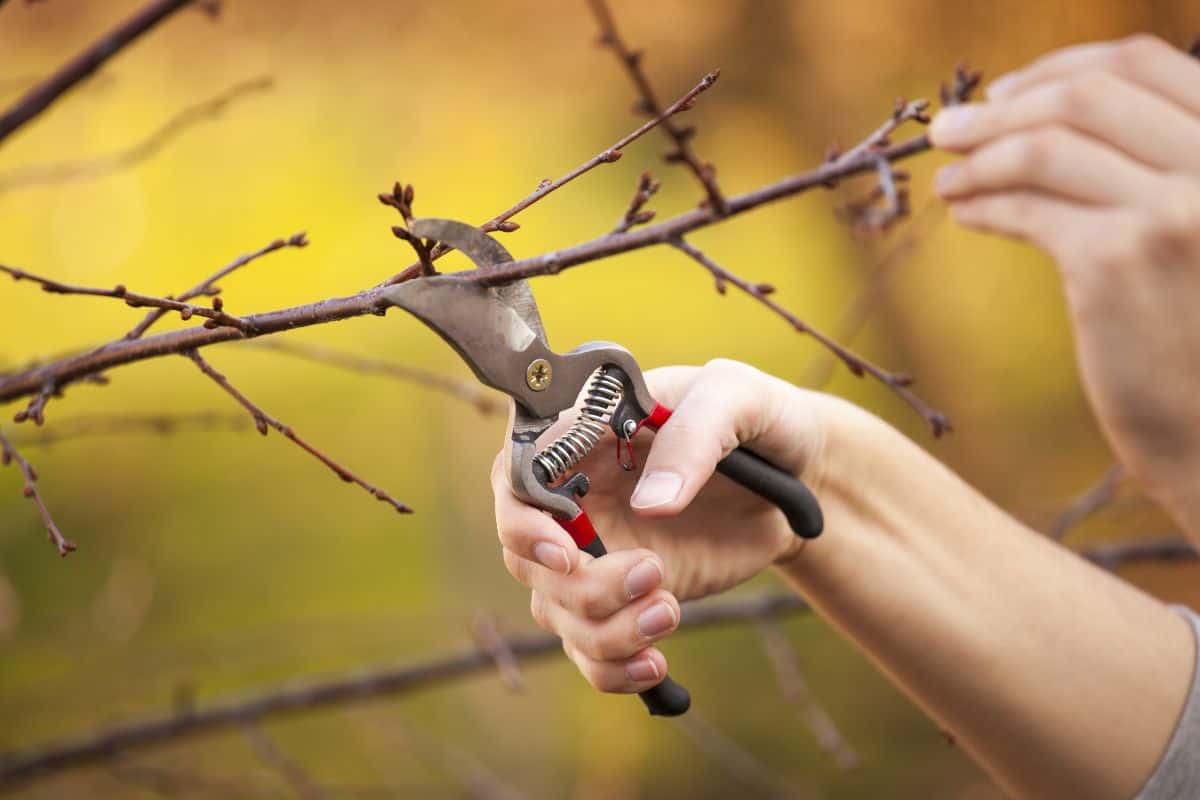
That is why early spring is the best time to prune peach trees. You can start pruning your peach trees when the peach buds swell and turn pink. Remember that you shouldn't prune the trees earlier than spring. Pruning at the right time will reduce the chances of pest attacks.
If shoots develop in the center of your peach trees, you can prune them anytime because these shoots will keep air and sunlight from reaching the fruit and impact your harvest. You should prune the shoots during summer so that fewer shoots will develop the following spring.
When Should I Fertilize My Peach Tree?
If you planted your peach tree in nutrient-filled soil, you will not need to fertilize it until it starts bearing fruit, when it's two to four years old.
You can conduct a soil test to find out if the soil is nutritious. If your tree does not grow an average of eight to 12 inches during the growing season, you can consider fertilizing the following spring.
Phosphorus helps with root development, so it's good for young trees. It's recommended to use complete fertilizers, like 16-4-8, 12-6-6, 12-4-8, or 10-10-10, during the tree's first three years.
Check out this complete 16-4-8 fertilizer on Amazon,
Once a peach tree reaches its fruit-bearing age, its nitrogen and potassium intake increases, so experts recommend using fertilizers with these nutrients once every early spring to ensure healthy growth.
Check out this potassium fertilizer on Amazon.
Are Peach Trees Hard To Grow?
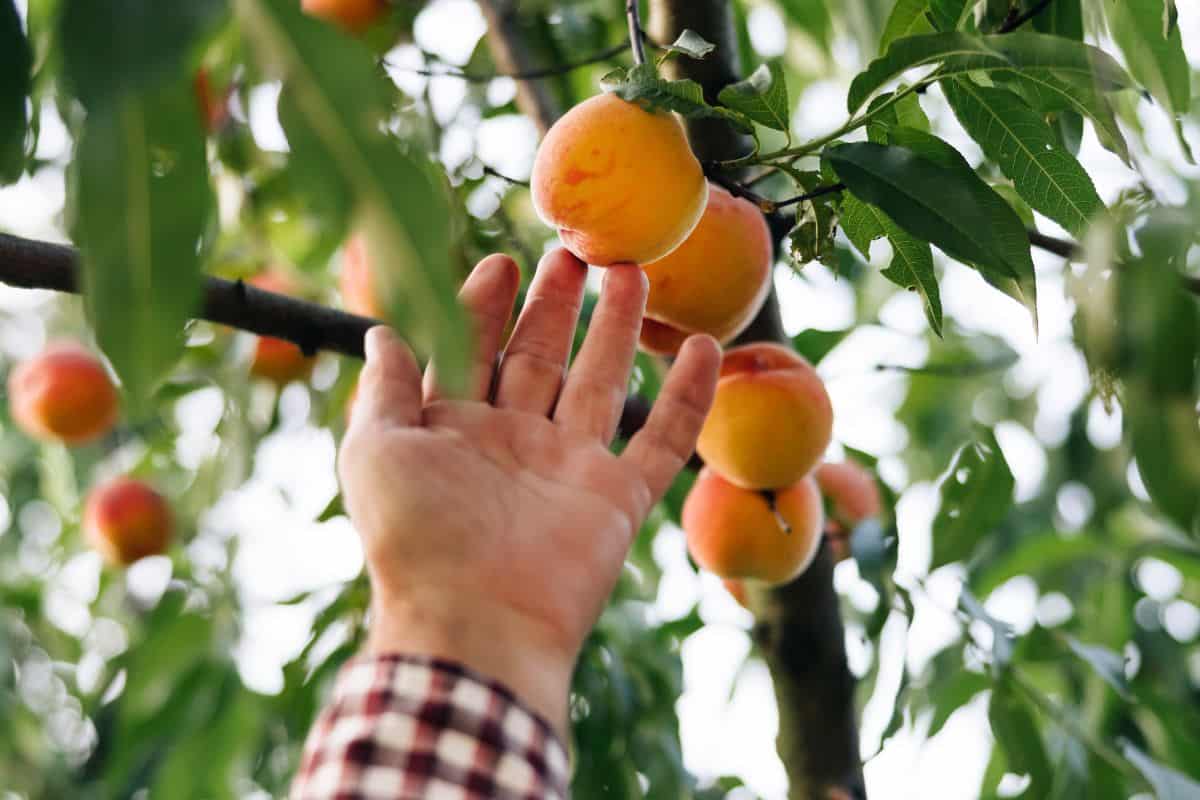
Peach trees are self-fruitful, meaning you won't need another tree nearby to pollinate them. Unlike other fruit trees that can't flower and bear fruit without other trees, a peach tree can flower even if it's alone.
You should choose a variety of peach tree that is compatible with your local climate. Some varieties are more susceptible to colder temperatures. You should thoroughly research the type of peach tree that's right for your climate if you don't want to waste time and money.
In USDA zones 5 to 8, most peach trees can be grown without any problem, so you don't need to consider the cold hardiness that much. You can focus on choosing a variety based on its flavor and harvest time.
However, if you live in zones with colder temperatures, there are peach tree varieties that are tolerant to cold weather.
Factors To Consider When Growing Peach Trees
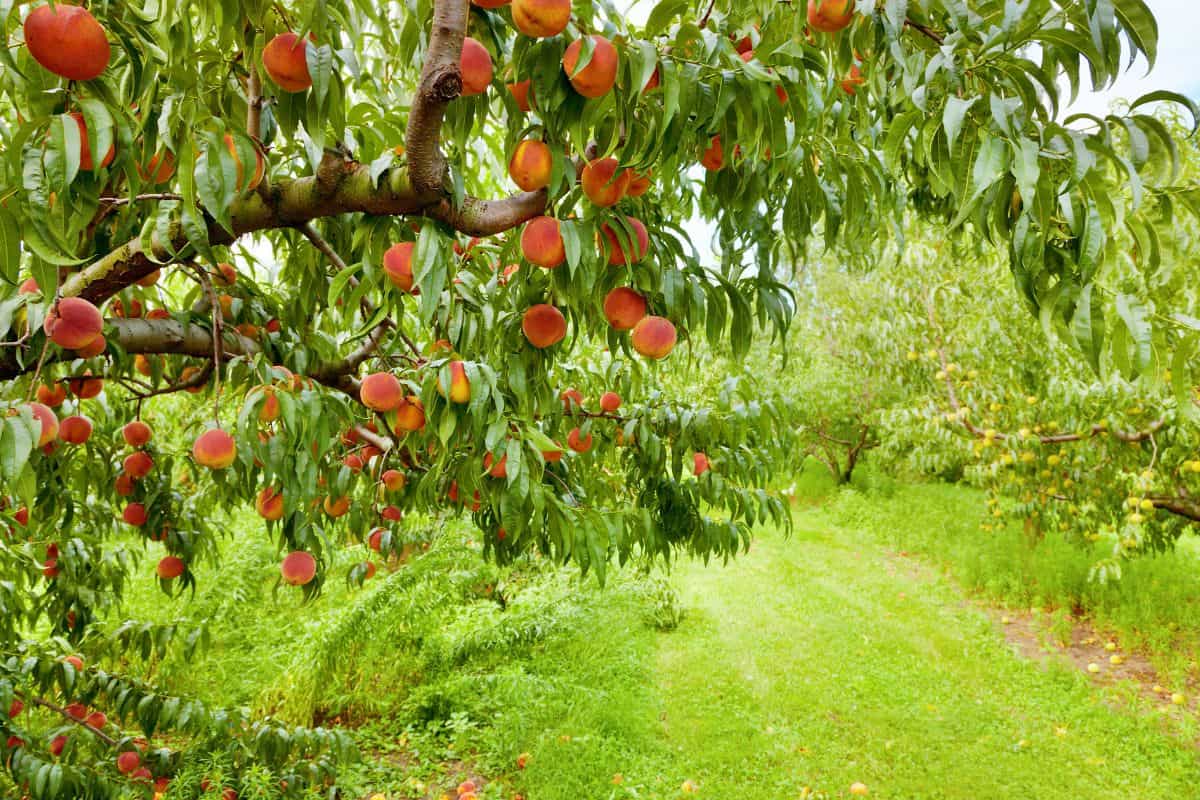
You must ensure that your peach tree is planted where it will get full sunlight. Peach trees need full sun in order to grow healthy. Don't plant your peach tree in shade or near buildings where the sunlight can get blocked. You should also plant it at an elevated position to ensure proper air circulation.
Another factor that should be considered when growing a peach tree is the soil. Peach trees can't survive in waterlogged soil, so it's ideal to plant them in loam soil. You also want to make sure that the soil can drain quickly and properly when it rains.
Lastly, you need to put in a constant effort to take care of your peach tree in order to avoid diseases. Peach trees can be sensitive to different kinds of diseases and pest infestations. Frequently check for symptoms and address them quickly to prevent your tree from dying.
Should I Water My Peach Tree Every Day?
Peach trees need to be watered an average of three times per week when they're young. As the trees grow and take root, you can water them less frequently.
You can generously soak the soil only when it's relatively dry. Doing this will encourage the roots to grow deeper into the ground, resulting in a sturdier tree.
A mature peach tree will need an average of 1-1.5 inches of water per week. If there is not enough rainfall, supplemental irrigation will be needed. You can water deeply two or three times a week. You can also spread mulch at a depth of two to four inches around the tree to help conserve soil moisture.
In Closing
Peach trees give us one of the sweetest, most delicious fruits, which is why many people grow them despite their short lifespans.
We hope this article has encouraged you to plant and grow your own peach tree. Make sure that you put in the effort and care in order to have the best outcome.
If you enjoyed this article, check out these similar posts below!
The Secret To Faster Plant Growth Is In Your Pantry – Watch As These Gardeners Unveil Their Secrets!



